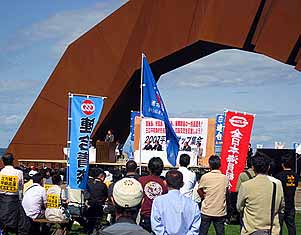10.02.2009
January 30, 2009 (the date of publication in Russian)
Alexei Chichkin
WHERE DID "THE NORTHERN TERRITORIES" ORIGINATE FROM?
Japanese territorial claims against the Russian Federation are based on foreign-policy myths creation
 Japan celebrates so-called "Day of Northern Territories" (that's how official Tokyo calls Kuril Islands) on February 7. Demonstrations in front of the building of Russian Embassy, nationalist and radical demonstrations, the Prime Minister's and deputies' speeches with demands to "re-establishing historical justice" are quiet typical for this day. Repeating annually, these demonstrations form ill attitude to Russia in minds of many Japanese, feed still persisting chauvinistic complexes.
Japan celebrates so-called "Day of Northern Territories" (that's how official Tokyo calls Kuril Islands) on February 7. Demonstrations in front of the building of Russian Embassy, nationalist and radical demonstrations, the Prime Minister's and deputies' speeches with demands to "re-establishing historical justice" are quiet typical for this day. Repeating annually, these demonstrations form ill attitude to Russia in minds of many Japanese, feed still persisting chauvinistic complexes.
So what are Japanese territorial claims against Russia based on? What's strange, they origin from local Japanese laws, but not from international law. As everyone knows, since 1953 Japanese side officially considers South Kurile District to be so-called "Northern Territories", the part of Hokkaido prefecture, but not the part of Kuril Archipelago. And they also refuse to admit that their territorial belonging wasn't defined in Treaty of San Francisco in 1951 (which became valid in 1952).
Meanwhile, the Japanese government reported to the military administration of the USA that it acknowledged Soviet-Japanese border all over its length already in 1947. Douglas MacArthur, the US Supreme Commander of Allied Forces of that time, had officially confirmed that. By the end of 1947 both sides totally demarcated the border, including its sea parts. The more – that time Tokyo didn't even intend to separate South Kurile District from the rest of Kuril Range. So the creation of Sakhalin District, which also includes whole Kuril archipelago, was based exactly on this mutual demarcation of borders.
And what concerns Treaty of San Francisco, it defines clearly, that "Japan renounces all right, title and claim to the Kurile Islands, and to that portion of Sakhalin and the islands adjacent to it over which Japan acquired sovereignty as a consequence of the Treaty of Portsmouth of 5 September 1905". And actually it was an integral Japanese administrative region till September 2, 1945 (which means till the capitulation of Japan). And still there has never been any separate South Kuril region owned by Japan.
So where did the famous "Northern Territories" origin from? It all began when in the end of April, 1952 the US Congress accepted open-ended resolution about the need of reconsideration of conditions of the mentioned agreement and other Japanese allied documents. And the same resolution offered the US government to consider the whole Southern Sakhalin (!) an illegally separated territory.
The Department of State affirmed the document already in the beginning of March, 1952. And even though its status wasn't raised to the level of a law, the USA keeps the recommended position up to this date, at least what concerns South Kurile District. And of course, the USSR protests produced no effect.
And since April, 1953 Japanese government included four South-Kuril islands (Kunashir, Iturup, Shikotan and Habomai) with adjacent water area in the Hokkaido province and called them "Northern Territories". And a propagandistic hysteria, aimed to convince the citizens of the Land of the Rising Sun that these lands actually are "originally Japanese", began exactly that time. But is it true? We can give some facts, which prove the opposite.
1772. Japan informed Russia that it concerned Nemuro, Mombetsu and Wakkanai to be its Northern-border cities. In other words it's Northern and Eastern bank of Hokkaido Island.
1786. Catherine II, Empress of Russia, promulgated a decree, which said that "the Kuril Land" belonged to the number of Siberian territories as "Russian lands, discovered by Russian seafarers and being habited by Russians". During the same year Russia and Japan signed a new trade agreement, which in particular affirmed that the Russian-Japan border came through "the Northern bank of Matsumae Island, which became Japanese"
1787. The trade mission's report to the head of Japanese government says that Iturup and others islands near Hokkaido are foreign territories and the Ainu from Hokkaido want to become autonomous from Japan.
1805. According to Alexander I order Colonel Resanov signed a protocol with the Japanese government, which said that "all lands and waters to the North from Matmai (the Russian-language interpretation of Hokkaido) belong to the Russian Emperor".
And finally in 1909, after Russo-Japanese War was over, a book called "The History of the Ainu and Northern Japan" was published in Yokohama. In particular, it pointed that all the islands to the North from Hokkaido were discovered and mastered by the Russians. And the "name "Kurilskiye" (which means "smoking" in Russian) was given by the Russians because of constantly smoking volcanoes and hot waters". So when Japan captured Kuril Islands that time, it considered them to be a "colony", but not a historical part of their national territory.
Thus, the idea of giving "Northern Territories" back as native lands to Japan is only a well-done product of political myths creation, which has absolutely no historical basis.
Number of shows: 1364
 ENG
ENG 

 ENG
ENG 
